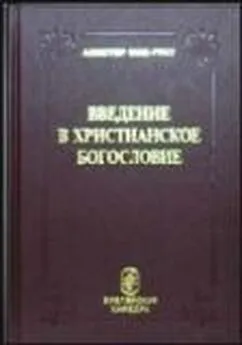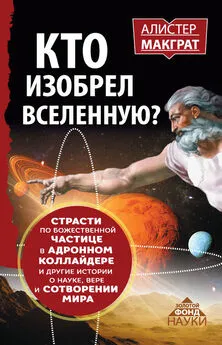Алистер Макграт - Является ли «научное богословие» интеллектуальным нонсенсом? Диалог с Ричардом Докинзом.
- Название:Является ли «научное богословие» интеллектуальным нонсенсом? Диалог с Ричардом Докинзом.
- Автор:
- Жанр:
- Издательство:Blackwell Publishing
- Год:2006
- ISBN:978-1-4051-2556-7
- Рейтинг:
- Избранное:Добавить в избранное
-
Отзывы:
-
Ваша оценка:
Алистер Макграт - Является ли «научное богословие» интеллектуальным нонсенсом? Диалог с Ричардом Докинзом. краткое содержание
Недавно вышедшая на русском языке книга Р. Докинза «Бог как иллюзия» вызвала как в интернет-сообществе, так и в печати оживленную дискуссию о характере диалога науки и религии в современном мире. В данной статье, являющейся первой главой книги «Порядок вещей», автор, профессиональный биолог и богослов, дает обстоятельный ответ на вызовы христианскому богословию, представленные в сочинениях проф. Докинза.
Является ли «научное богословие» интеллектуальным нонсенсом? Диалог с Ричардом Докинзом. - читать онлайн бесплатно полную версию (весь текст целиком)
Интервал:
Закладка:
[24]
Richard Dawkins, A Devil's Chaplain. London:Weidenfeld&Nicolson, 2003, 139.
[25]
Для более детального рассмотрения см. Robert D. Sider, «Credo Quia Absurdum?» Classical World 73 (1978): 417-19.
[26]
Tertullian, de paenitentia v, 4. «Crucifixus est dei filius; non pudet, quia pudendum est. Et mortuus est dei filius; credibile prorsus est, quia ineptum est. Et sepultus resurrexit; certum est, quia impossibile».
[27]
James Moffat, «Tertullian and Aristotle». Journal of Theological Studies 17 (1916): 170-1.
[28]
См.: Robert D. Sider, Ancient Rhetoric and the Art of Tertullian. Oxford: Oxford University Press, 1971, 56-9.
[29]
Tertullian, de poenitentia I, 2. «Quippe res dei ratio quia deus omnium conditor nihil non ratione providit disposuit ordinavit, nihil enim non ratione tractari intellegique voluit».
[30]
W. H. Griffith-Thomas, The Principles of Theology. London: Longmans, Green, 1930, xviii. Вера, таким образом, включает «уверенность в свидетельстве» и «несомненную верность»; она не «слепая, но разумная» (xviii-xix).
[31]
Я имел ввиду работы следующих авторов: Richard Swinburne, The Coherence of Theism. Oxford: Clarendon Press, 1977; Nicholas Wolterstorff, Reason within the Bounds of Religion. Grand Rapids, MI: Eerdmans, 1984; Alvin Plantinga, Warranted Christian Belief. Oxford: Oxford University Press, 2000.
[32]
Elliott R. Sober, «Modus Darwin». Biology and Philosophy 14 (1999): 253-78.
[33]
Richard Swinburne, The Resurrection of God Incarnate. Oxford: Clarendon Press, 2003.
[34]
Timothy Shanahan, «Methodological and Contextual Factors in the Dawkins/ Gould Dispute over Evolutionary Progress». Studies in History and Philosophy of Science 31 (2001): 127-51.
[35]
Gilbert Harman, «The Inference to the Best Explanation». Philosophical Review 74 (1965): 88-95. Недавнее исследование этой важной темы в философии науки представлено в: Peter Lipton, Inference to the Best Explanation. London: Routledge, 2004.
[36]
Paul R. Thagard, «The Best Explanation: Criteria for Theory Choice». Journal of Philosophy 75 (1976): 76-92, quote at 77.
[37]
Thagard, «The Best Explanation»,74.
[38]
См. Michael Ruse, «Darwin's Debt to Philosophy: An Examination of the Influence of the Philosophical Ideas of John F. Herschel and William Whewell on the Development of Charles Darwin's Theory of Evolution». Studies in the History and Philosophy of Science 66 (1975): 159-81; Richard R. Yeo, «William Whewell's Philosophy of Knowledge and Its Reception». В William Whewell: A Composite Portrait, edited by Menachem Fisch and Simon Schaffer, 175-99. Oxford: Clarendon Press, 1991.
[39]
S. A. Kleiner, «Problem Solving and Discovery in the Growth of Darwin's Theories of Evolution». Synthese 62 (1981): 119-62, especially 127-9.
[40]
Charles Darwin, The Origin of Species. Harmondsworth: Penguin, 1968, 230.
[41]
Darwin, The Origin of Species, 205.
[42]
Harman, «Inference», 89. Теории могут быть описаны как пригодные для данного случая, если они разрабатываются для специфической и ограниченной цели объяснения известных явлений (иногда рассматриваются как «ретродукция»). Они контрастируют с предсказательными теориями, которые порождают новые предсказания, которые не содержатся в известных наблюдениях.
[43]
Как указывает Gerd Buchdahl, «History of Science and Criteria of Choice». In Minnesota Studies in the Philosophy of Science, edited by Roger H. Steuwer, 204-30. Minneapolis: University of Minnesota Press, 1970.
[44]
Nancy Cartwright, How the Laws of Physics Lie. Oxford: Clarendon Press, 1983.
[45]
Как полагает Bas van Fraassen, «The Pragmatics of Explanation». American Philosophical Quarterly 14 (1977): 143-50.
[46]
James R. Moore, The Post-Darwinian Controversies: A Study of the Protestant Struggle to Come to Terms with Darwin in Great Britain and America, 1870-1900. Cambridge: Cambridge University Press, 1979.
[47]
C. S. Lewis, «Is Theology Poetry?» In C. S. Lewis: Essay Collection, 1-21. London: Collins, 2000, quote at 21.
[48]
Эта точка зрения акцентирована физиком и богословом Джоном Полкинхорном. См.: John Polkinghorne, TheWay theWorld Is. London: SPCK, 1983; Science and Creation: The Search for Understanding. London: SPCK, 1988.
[49]
The Selfish Gene, 192.
[50]
The Selfish Gene, 193.
[51]
John A. Ball, «Memes as Replicators». Ethology and Sociology 5 (1984): 145-61.
[52]
A Devil's Chaplain, 145.
[53]
A Devil's Chaplain, 124.
[54]
Я использую обе иллюстрации в своей книге: Alister McGrath, Creation. London: SPCK, 2004.
[55]
Juan D. Delius, «The Nature of Culture». In The Tinbergen Legacy, edited by M. S. Dawkins, T. R. Halliday, and R. Dawkins, 75-99. London: Chapman & Hall, 1991.
[56]
Daniel Rothbart, «The Semantics of Metaphor and the Structure of Science». Philosophy of Science 51 (1984): 595-615.
[57]
Bunge, Method, Model, and Matter. Dordrecht: D. Reidel, 1973, 125-6.
[58]
See Alister E. McGrath, The Twilight of Atheism. New York: Doubleday, 2004.
[59]
Simon Conway Morris, Life's Solution: Inevitable Humans in a Lonely Universe. Cambridge: Cambridge University Press, 2003, 324.
[60]
A Devil's Chaplain, 121.
[61]
A Devil's Chaplain, 135.
[62]
Aaron Lynch, Thought Contagion: How Belief Spreads through Society. New York: Basic Books, 1996.
[63]
Aaron Lynch, «An Introduction to the Evolutionary Epidemiology of Ideas». Biological Physicist 3, No. 2 (2003): 7-14.
[64]
Stephen Shennan, Genes, Memes and Human History: Darwinian Archaeology and Cultural Evolution. London: Thames & Hudson, 2002, 63. Shennan cites the work of Luca Cavalli-Sforza and Marcus Feldman in support: Cultural Transmission and Evolution: A Quantitative Approach. Princeton, NJ: Princeton University Press, 1981.
[65]
Richard Dawkins, «A Survival Machine». In The Third Culture, edited by John Brockman, 75-95. New York: Simon & Schuster, 1996.
[66]
Отличным примером этого являются работы Джона Раскина. См. Michael Wheeler, Ruskin's God. Cambridge: Cambridge University Press, 1999.
[67]
Dawkins, Unweaving the Rainbow, xiii. См. также его обширную дискуссию, касающуюся как традиционной религии, так и движения «Newage» на стр. 114-179.
[68]
См. дискуссию в работе: Arthur C. Danto, The Transfiguration of the Commonplace: A Philosophy of Art. Cambridge,MA: Harvard University Press, 1981, 1-32.
[69]
Unweaving the Rainbow, xii.
[70]
Unweaving the Rainbow, 17.
[71]
Charles Gore,The Incarnation of the Son of God. London: JohnMurray, 1922,105-6.
[72]
A Devil's Chaplain, 19.
[73]
Richard Dawkins, The Selfish Gene, 2nd edn. Oxford: Oxford University Press, 1989, 198.
Апологетическое (основное) богословие, Религия и наука
Портал Богослов.Ru АНО "ЦИТ МДА".
Все права защищены 2007-2011. Свидетельство о регистрации СМИ Эл № ФС77-46659 от 22.09.2011
При копировании материалов с сайта ссылка обязательна в формате:
Источник: Портал Богослов.Ru.
Мнение редакции может не совпадать с мнением авторов публикаций.
Редакция открыта к сотрудничеству и готова обсудить предложения.
Интервал:
Закладка:




